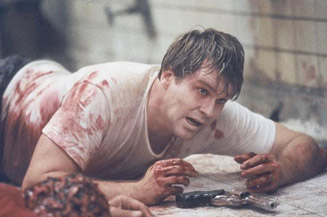What Went Right: Saw
By Shalimar Sahota
February 9, 2012
This will go into a few spoilers, so if you haven’t seen Saw, then be warned that the film features a scene where a man uses a stethoscope… to hear a heart beating. Sordid stuff, I tell you.
Back in 2004, I was studying while working at an independent multiplex cinema. On October 1st, one of my lessons was cancelled, so it meant that I could catch the first showing of Saw. I recalled seeing huge billboard posters for the film, with the tagline, “Dare you see Saw?” I took up the dare. I only realized my mistake moments later when angry parents were chasing me from a children’s playground.
Supposedly the culprit when it comes to “torture porn” (blame the sequels), Saw is often labelled as a horror film, yet it’s more a gory thriller. However, there’s not really as much blood as you’d expect. A noticeable lack of on-screen stabbing and sawing means that the sound is ramped up to uncomfortable levels. Director James Wan had to be creative with the low budget. The money isn’t there to show someone being killed by multiple shotgun blasts, but you can get away with effectively showing the outcome.
James Wan and Leigh Whannell met while studying at the Royal Melbourne Institute Of Technology in Australia. They wanted to make their own films together, and for their first film decided on keeping the premise simple enough so that they could shoot on a low budget. Wan gave the idea to Whannell about two guys chained to opposite ends of a bathroom. One was Dr. Lawrence Gordon (who would eventually be played by Cary Elwes); the other, Adam (whom Whannell would go on to play). These characters were stuck, had no idea how they got there and lying between them was a body. Whannell started writing the script for Saw in 2001. It took him around nine months to finish the first draft, trying to work out why they were chained up and who put them there. He came up with a story that involved a deranged serial killer named Jigsaw (Tobin Bell), who abducted his wayward victims only to have them play dangerous games as they attempted to win their lives back. A bit like playing that old party favourite Truncate Twister.
Intending to film Saw themselves, they had saved up $5,000 of their own money. Their agent (the film’s eventual executive producer), Stacey Testro, suggested that they try to secure some funding to do the film properly. After spending a year to see if anyone would finance their film, no deal ever got close to being finalised. So Testro suggested that they take their script to Hollywood.
What’s interesting here is that rather than just submit a script, they used the $5,000 they had saved to film a small segment to help give a flavor of what Saw would be like. The result was a short film which involved Whannell playing a character named David, telling the story of how he’d been captured and forced to play a deadly game. It was frighteningly dark and successfully put across the tone of what would become the feature film. Shot on 16mm, Wan converted the footage to DVD, so when producers and production companies received the script for Saw, they got a short film as well. If the duo hadn’t shot the short film then they may still be looking for funding, for in nearly every instance people watched the DVD first, simply because it was quicker than reading a script and it made people want to read the script.
Continued:
1
2
3
|
|
|
|




